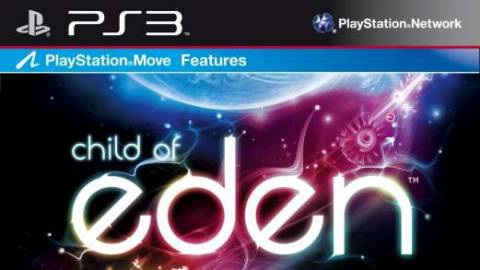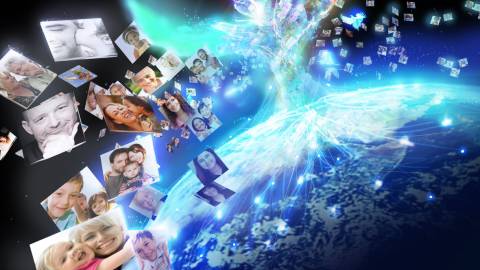Overview
Child of Eden is an on-rails shooter designed around rhythm, much like its spiritual successor Rez. The game was released on June 14, 2011 for Xbox 360, and September 27th 2011 for PlayStation 3, where in Europe it also received a PlayStation Network release.
Story and Connection to Rez
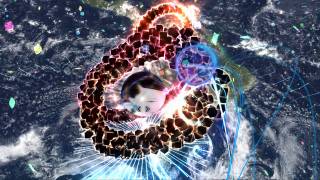
Child of Eden has graphics, level design, progression, music, and gameplay that are all highly reminiscent of Rez, the cult classic created by Tetsuya Mizuguchi. The game is a spiritual successor to Rez, and it seems possible that the stories of both games are contained within the same universe. The game is also an experiment in synaesthesia, just like Rez. This stems from Mizuguchi's passion for the work of artist Wassily Kandinsky.
In Child of Eden, a girl named Lumi is the first human born in outer space. When she dies, her memories and personality are archived in the internet, which is referred to as Eden in the game. Two centuries after her death, scientists attempt to recreate her persona within the confines of Eden. The game begins as Lumi awakes in Eden.
Eden was the name of the artificial intelligence that the player is trying to rescue in Rez, suggesting a narrative connection between the two games.
Levels
Each level has a different theme to it. There are a total of 5 levels plus a bonus challenge level.
Matrix
Matrix is the very first stage in the game. The level starts off with a tutorial in a tunnel made of blocks. After that, the tunnel opens up and you descend a sort of shaft with FMV bubbles rising up the walls. After ascension, you face a wall where you must shoot red cubes to unveil a glowing ball that you must shoot. After a couple of shots, the ball reforms the wall and you must repeat. Afterwards you find yourself in another tunnel where you must destroy walls that turn into cubes to proceed. Afterwards, you find yourself in front of a giant construct where you must shoot three balls. Then, you must shoot the blinking lights on the construct's walls which then turn into thousands of little cubes that form around a ball that you must destroy to complete the level.
Evolution
Evolution is the second stage in the game. The theme to this level is water. The level starts with little cells that you shoot, which divide after each shot. The level takes the player up a sort of trunk that is the symbol of evolution as it glows to the music. You end up meeting giant manta rays that you must shoot the plankton off of. You end up meeting a whale that is flying away from a planet. The whale eventually turns into a phoenix, symbolizing that evolution can rise from nothing. After shooting the phoenix, images of Lumi begin appearing, ending the level.
Beauty
Beauty is the third stage in the game. The theme to this level is natures. You start the level over a pond where you buds turn into flowers and flying cocoons into butterflies. You then enter a stage that seems to be inside multiple trees, shooting caterpillars before going into a luminescent tunnel and shooting abstract creatures. The level ends with a boss that's a flower, its weakness being its bud. The flower will have multiple red spots appear on its pedals that you must shoot before they unleash projectiles. The bud, once defeated reveals, like in the other boss fights, Lumi.
Passion
Passion is the fourth stage and is themed around urbanization. The level starts with the player shooting a blob that turns into a red and blue planet. The planets violently collide and send the player to a abstract industrial environment where cogs must be hit to open gates and enemies are flying planes. The player is then taken to narrow space between two cities that get closer to each other after each beat. The player is then taken back to the two colliding planets who have now turned into two running men who are racing down a tunnel and eventually jump transporting players to a new tunnel with old trains that must be turned into high speed, modern ones. At the same time, the player is attacked by fighter jets and must shoot a space ship that turns into a satellite. After that, the player is teleported to the inside of a sphere and surrounded by wire framed structures which he must shoot. The level then shifts to a sort of board that the player shoots to create a clock on which the player defeats the two planets.
Journey
Journey is the final stage of Child of Eden and is a mash up of all the different bosses. It concludes with you saving Lumi and interactive credits.
Gameplay

Similar to Rez, Child of Eden is an on-rails shooter with a procedurally generated soundtrack. Like in Rez, players can lock on to targets by aiming at them with an on-screen cursor and then release the lock-on button to shoot said targets. There is also--just like in Rez--a smart bomb called Euphoria that clears the screen for a short time. However, Child of Eden introduces two new gameplay features. The first is that, if the maximum number of lock-ons is achieved, the player will get a score multiplier if he or she shoots in rhythm to the music. The score multiplier can go up to 8. You know when you're perfectly in rhythm when the words "Perfect!!" appear on screen along with your multiplier. If instead of perfect you get good, your multiplier stays the same. If you do not get anything, your multiplier goes back to one. Like in Rez, the controller vibrates in tandem with the beat of the song that's playing. You are required to let go of the lock on at just the right instance to upgrade your multiplier. Another addition is that of the Tracer weapon. The tracer weapon is another way to shoot in Child of Eden. It's a fully automatic weapon that is meant to be used against purple-colored enemies, as well as enemy projectiles (which can not be locked on to). The tracer does nothing to your multiplier but adds sounds to the level's song. As mentioned before, some projectiles only work with certain enemies. For example, a giant serpent like creature is purple. You must first attack it with the Tracer until it turns blue before you can use the lock-on. his becomes exceedingly important in later parts of the game.
The game also features Kinect and Move support. With the Kinect controller, players use their left hand to shoot the Tracer and their right to shoot the lock-on laser. If a player raises both of his or her hands, the smart bomb (called Euphoria in Child of Eden) is released.
Graphics
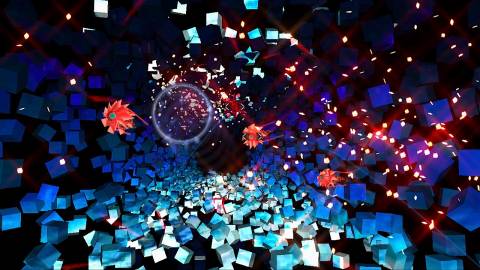
As was the case in Rez, Child of Eden features colorful, abstract visual design. The difference, however, is that the processing power of the Xbox 360 and PlayStation 3 have allowed for much more fluid and organic-looking visuals, as opposed to the prevalence of hard angles and wireframe models in the arguably minimalist design of Rez, which was originally for the Sega Dreamcast. Child of Eden doesn't look entirely dissimilar, though, as it has its own moments of minimalist design.
Players can unlock visual skins, which change the color palette of the game (yet another feature that returns from Rez).
The PlayStation 3 version of the game features 3D support as well.
Music
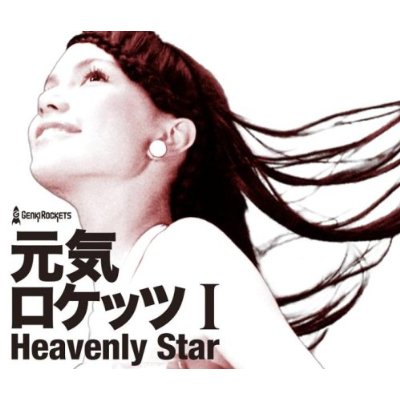
The music of the game is partly composed by Tetsuya Mizuguchi's band, Genki Rockets, and partly determined by the gameplay. Just like in Rez, all player actions have music cues to accompany them. The game also features rhythmic force feedback (another feature of Rez), even when a player is using Kinect. Additional controllers can be turned on and set to vibrate along to the music, and each controller has a different rhythm. Q Entertainment even built a special harness for four controllers that they used in developing the game.
Players can also unlock real-time audio filters to use during gameplay.
Announcement and Promotion
At the E3 2010 Ubisoft press conference, Child of Eden was revealed as the new project from Tetsuya Mizuguchi's Q Entertainment. It was played on-stage with Microsoft's Kinect controller, but it will be available for both Xbox 360 and PlayStation 3 with Move support for the PS3 version.
To promote the game, Ubisoft partnered with Kongregate--an online portal for free Flash and Unity3D games--to sponsor a game development contest judged by Mizuguchi himself. Entries may be played for free here. Ubisoft also rented an entire store in London to serve as a place for people to try Child of Eden for themselves. It featured a demo station with a hundred-inch screen, as well as smaller demo stations with Kinect controllers and a lounge.
Reception
Early critical reactions to the game have been positive, with many critics championing it as the first good reason to own a Kinect. Most critics also mentioned the aesthetic beauty and emotional resonance of the game. As of June 15, 2011, the game has a Metacritic score of 85.
Xbox 360 Game Installation
Installing this game to the Xbox 360 hard drive requires 2.4GB of memory.

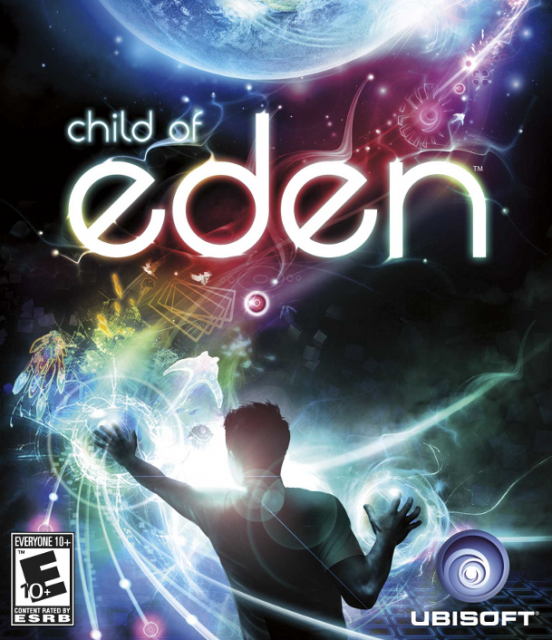
 Xbox 360
Xbox 360 PlayStation 3
PlayStation 3 Xbox 360 Games Store
Xbox 360 Games Store.png) PlayStation Network (PS3)
PlayStation Network (PS3)

